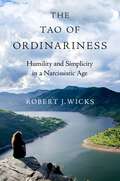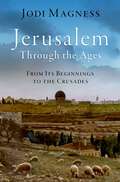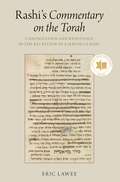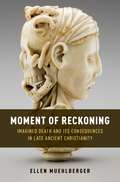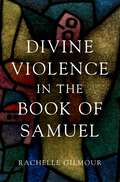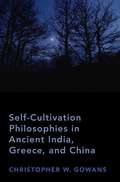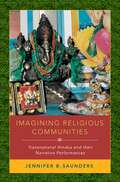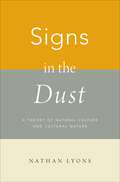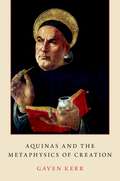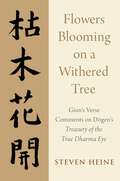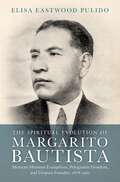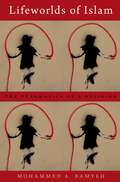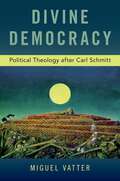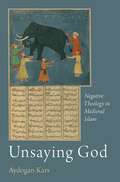- Table View
- List View
The Tao of Ordinariness: Humility and Simplicity in a Narcissistic Age
by Robert J. WicksThis book is an invitation to come home to your authentic self in a world that is frequently mesmerized by "spin," narcissism, fantasy, and exhibitionism. Psychology and classic wisdom literature have, in various ways, long recognized the value for simply becoming who you are (i.e., ordinariness). However, this call is becoming increasingly drowned out by the many other voices that emphasize publicity and image-making over authenticity and humility. Renowned therapist and author Robert Wicks has written The Tao of Ordinariness as a way of beginning to address these tendencies in contemporary society. In this new countercultural work, the strength and joy of exploring who you are - and proceeding to share yourself with others in a way that they too can reclaim themselves - is revisited from a range of vantage points. The author specifically reexamines themes of humility, simplicity, letting go, self-awareness, "alonetime," resilience, and mentoring. In an era when people increasingly measure self-worth by external measures, such as the number of likes and views and followers on social media feeds (which have many individuals chasing impossible fantasies and living with a constant fear of "missing out"), Wicks offers a return to your authentic self.
The Tao of Ordinariness: Humility and Simplicity in a Narcissistic Age
by Robert J. WicksThis book is an invitation to come home to your authentic self in a world that is frequently mesmerized by "spin," narcissism, fantasy, and exhibitionism. Psychology and classic wisdom literature have, in various ways, long recognized the value for simply becoming who you are (i.e., ordinariness). However, this call is becoming increasingly drowned out by the many other voices that emphasize publicity and image-making over authenticity and humility. Renowned therapist and author Robert Wicks has written The Tao of Ordinariness as a way of beginning to address these tendencies in contemporary society. In this new countercultural work, the strength and joy of exploring who you are - and proceeding to share yourself with others in a way that they too can reclaim themselves - is revisited from a range of vantage points. The author specifically reexamines themes of humility, simplicity, letting go, self-awareness, "alonetime," resilience, and mentoring. In an era when people increasingly measure self-worth by external measures, such as the number of likes and views and followers on social media feeds (which have many individuals chasing impossible fantasies and living with a constant fear of "missing out"), Wicks offers a return to your authentic self.
Jerusalem through the Ages: From Its Beginnings to the Crusades
by Jodi MagnessA major new history of one of the world's holiest of cities, based on the most recent archaeological discoveries First settled five thousand years ago by a mountain spring between the Mediterranean and Dead Sea, Jerusalem was named for the god (Shalem) that was worshipped there. When David reportedly conquered the city, ca. 1000 BCE, he transferred the Ark of the Covenant--and with it, the presence of the God of Israel--to this rocky outcrop. Here, David's son Solomon built a permanent house for the God of Israel called the first temple, and since then this spot has been known as the Temple Mount. After Babylonians destroyed Solomon's temple in 586 BCE, it was replaced by the second temple, which is the setting for many of the events described in the Gospel accounts. In 70 CE, the Romans destroyed Jerusalem, leaving the Temple Mount in ruins. Two hundred and fifty years later, the emperor Constantine constructed the Church of the Holy Sepulcher around the spots where Jesus is believed to have been crucified and buried, and the church is now considered Jerusalem's holiest site by many Christians worldwide. In the late seventh century CE the focus shifted back to the Temple Mount, when an early Islamic ruler named `Abd al-Malek enshrined the rocky outcrop in a monument that is still iconic of the city today: the Dome of the Rock. In 1099 Crusaders conquered Jerusalem, and although their rule was brief rule they left a deep impact on the city. Today, much of the old city retains its medieval appearance. For followers of the three Abrahamic faiths, Jerusalem is the place where the presence of the God of Israel dwells--the meeting point of heaven and earth and the locus of divine and human interaction. Jerusalem through the Ages by Jodi Magness explores how these beliefs came to be associated with the city by introducing readers to its complex and layered history, providing a broad yet detailed account, including the most recent archaeological discoveries. Each chapter focuses on a key moment of transition from Jerusalem's beginnings to the Crusades of the medieval period, enabling readers to experience the city's many transformations as it changed hands and populations-Jebusites, Israelites, Judahites, Persians, Greeks, Romans, Jews, Christians, and Muslims. The book also includes a walking guide for visitors who wish to experience the city's many archaeological sites firsthand.
Jerusalem through the Ages: From Its Beginnings to the Crusades
by Jodi MagnessA major new history of one of the world's holiest of cities, based on the most recent archaeological discoveries First settled five thousand years ago by a mountain spring between the Mediterranean and Dead Sea, Jerusalem was named for the god (Shalem) that was worshipped there. When David reportedly conquered the city, ca. 1000 BCE, he transferred the Ark of the Covenant--and with it, the presence of the God of Israel--to this rocky outcrop. Here, David's son Solomon built a permanent house for the God of Israel called the first temple, and since then this spot has been known as the Temple Mount. After Babylonians destroyed Solomon's temple in 586 BCE, it was replaced by the second temple, which is the setting for many of the events described in the Gospel accounts. In 70 CE, the Romans destroyed Jerusalem, leaving the Temple Mount in ruins. Two hundred and fifty years later, the emperor Constantine constructed the Church of the Holy Sepulcher around the spots where Jesus is believed to have been crucified and buried, and the church is now considered Jerusalem's holiest site by many Christians worldwide. In the late seventh century CE the focus shifted back to the Temple Mount, when an early Islamic ruler named `Abd al-Malek enshrined the rocky outcrop in a monument that is still iconic of the city today: the Dome of the Rock. In 1099 Crusaders conquered Jerusalem, and although their rule was brief rule they left a deep impact on the city. Today, much of the old city retains its medieval appearance. For followers of the three Abrahamic faiths, Jerusalem is the place where the presence of the God of Israel dwells--the meeting point of heaven and earth and the locus of divine and human interaction. Jerusalem through the Ages by Jodi Magness explores how these beliefs came to be associated with the city by introducing readers to its complex and layered history, providing a broad yet detailed account, including the most recent archaeological discoveries. Each chapter focuses on a key moment of transition from Jerusalem's beginnings to the Crusades of the medieval period, enabling readers to experience the city's many transformations as it changed hands and populations-Jebusites, Israelites, Judahites, Persians, Greeks, Romans, Jews, Christians, and Muslims. The book also includes a walking guide for visitors who wish to experience the city's many archaeological sites firsthand.
Rashi's Commentary on the Torah: Canonization and Resistance in the Reception of a Jewish Classic
by Eric LaweeWinner of the Jewish Book Council Nahum M. Sarna Memorial Award in Scholarship This book explores the reception history of the most important Jewish Bible commentary ever composed, the Commentary on the Torah of Rashi (Shlomo Yitzhaki; 1040-1105). Though the Commentary has benefited from enormous scholarly attention, analysis of diverse reactions to it has been surprisingly scant. Viewing its path to preeminence through a diverse array of religious, intellectual, literary, and sociocultural lenses, Eric Lawee focuses on processes of the Commentary's canonization and on a hitherto unexamined--and wholly unexpected--feature of its reception: critical, and at times astonishingly harsh, resistance to it. Lawee shows how and why, despite such resistance, Rashi's interpretation of the Torah became an exegetical classic, a staple in the curriculum, a source of shared religious vocabulary for Jews across time and place, and a foundational text that shaped the Jewish nation's collective identity. The book takes as its larger integrating perspective processes of canonicity as they shape how traditions flourish, disintegrate, or evolve. Rashi's scriptural magnum opus, the foremost work of Franco-German (Ashkenazic) biblical scholarship, faced stiff competition for canonical supremacy in the form of rationalist reconfigurations of Judaism as they developed in Mediterranean seats of learning. It nevertheless emerged triumphant in an intense battle for Judaism's future that unfolded in late medieval and early modern times. Investigation of the reception of the Commentary throws light on issues in Jewish scholarship and spirituality that continue to stir reflection, and even passionate debate, in the Jewish world today.
Rashi's Commentary on the Torah: Canonization and Resistance in the Reception of a Jewish Classic
by Eric LaweeWinner of the Jewish Book Council Nahum M. Sarna Memorial Award in Scholarship This book explores the reception history of the most important Jewish Bible commentary ever composed, the Commentary on the Torah of Rashi (Shlomo Yitzhaki; 1040-1105). Though the Commentary has benefited from enormous scholarly attention, analysis of diverse reactions to it has been surprisingly scant. Viewing its path to preeminence through a diverse array of religious, intellectual, literary, and sociocultural lenses, Eric Lawee focuses on processes of the Commentary's canonization and on a hitherto unexamined--and wholly unexpected--feature of its reception: critical, and at times astonishingly harsh, resistance to it. Lawee shows how and why, despite such resistance, Rashi's interpretation of the Torah became an exegetical classic, a staple in the curriculum, a source of shared religious vocabulary for Jews across time and place, and a foundational text that shaped the Jewish nation's collective identity. The book takes as its larger integrating perspective processes of canonicity as they shape how traditions flourish, disintegrate, or evolve. Rashi's scriptural magnum opus, the foremost work of Franco-German (Ashkenazic) biblical scholarship, faced stiff competition for canonical supremacy in the form of rationalist reconfigurations of Judaism as they developed in Mediterranean seats of learning. It nevertheless emerged triumphant in an intense battle for Judaism's future that unfolded in late medieval and early modern times. Investigation of the reception of the Commentary throws light on issues in Jewish scholarship and spirituality that continue to stir reflection, and even passionate debate, in the Jewish world today.
Moment of Reckoning: Imagined Death and Its Consequences in Late Ancient Christianity
by Ellen MuehlbergerLate antiquity saw a proliferation of Christian texts dwelling on the emotions and physical sensations of dying, not as a heroic martyr in a public square or a judge's court, but as an individual, at home in a bed or in a private room. In sermons, letters, and ascetic traditions, late ancient Christians imagined the last minutes of life and the events that followed death in elaborate detail. The majority of these imagined scenarios linked the quality of the experience to the moral state of the person who died. Death was no longer the "happy ending," in Judith Perkins's words, it had been to Christians of the first three centuries, an escape from the difficult and painful world. Instead, death was most often imagined as a terrifying, desperate experience. This book is the first to trace how, in late ancient Christianity, death came to be thought of as a moment of reckoning: a physical ordeal whose pain is followed by an immediate judgment of one's actions by angels and demons and, after that, fitting punishment. Because late ancient Christian culture valued the use of the imagination as a religious tool and because Christian teachers encouraged Christians to revisit the prospect of their deaths often, this novel description of death was more than an abstract idea. Rather, its appearance ushered in a new ethical sensibility among Christians, in which one's death was to be imagined frequently and anticipated in detail. This was, at first glance, meant as a tool for individuals: preachers counted on the fact that becoming aware of a judgment arriving at the end of one's life tends to sharpen one's scruples. But, as this book argues, the change in Christian sensibility toward death did not just affect individuals. Once established, it shifted the ethics of Christianity as a tradition. This is because death repeatedly and frequently imagined as the moment of reckoning created a fund of images and ideas about what constituted a human being and how variances in human morality should be treated. This had significant effects on the Christian assumption of power in late antiquity, especially in the case of the capacity to authorize violence against others. The thinking about death traced here thus contributed to the seemingly paradoxical situation in which Christians proclaimed their identity with a crucified person, yet were willing to use force against their ideological opponents.
Divine Violence in the Book of Samuel
by Rachelle GilmourMuch of the drama, theological paradox, and interpretive interest in the Book of Samuel derives from instances of God's violence in the story. The beginnings of Israel's monarchy are interwoven with God's violent rejection of the houses of Eli and of Saul, deaths connected to the Ark of the Covenant, and the outworking of divine retribution after David's violent appropriation of Bathsheba as his wife. Whilst divine violence may act as a deterrent for violent transgression, it can also be used as a model or justification for human violence, whether in the early monarchic rule of Ancient Israel, or in crises of our contemporary age. In Divine Violence in the Book of Samuel, Rachelle Gilmour explores these narratives of divine violence from ethical, literary, and political perspectives, in dialogue with the thought of Immanuel Kant, Martha Nussbaum and Walter Benjamin. She addresses such questions as: Is the God of Samuel a capricious God with a troubling dark side? Is punishment for sin the only justifiable violence in these narratives? Why does God continue to punish those already declared forgiven? What is the role of God's emotions in acts of divine violence? In what political contexts might narratives of divine violence against God's own kings, and God's own people have arisen? The result is a fresh commentary on the dynamics of transgression, punishment, and their upheavals in the book of Samuel. Gilmour offers a sensitive portrayal of God's literary characterization, with a focus on divine emotion and its effects. By identifying possible political contexts in which the narratives arose, God's violence is further illumined through its relation to human violence, northern and southern monarchic ideology, and Judah's experience of the Babylonian exile.
Divine Violence in the Book of Samuel
by Rachelle GilmourMuch of the drama, theological paradox, and interpretive interest in the Book of Samuel derives from instances of God's violence in the story. The beginnings of Israel's monarchy are interwoven with God's violent rejection of the houses of Eli and of Saul, deaths connected to the Ark of the Covenant, and the outworking of divine retribution after David's violent appropriation of Bathsheba as his wife. Whilst divine violence may act as a deterrent for violent transgression, it can also be used as a model or justification for human violence, whether in the early monarchic rule of Ancient Israel, or in crises of our contemporary age. In Divine Violence in the Book of Samuel, Rachelle Gilmour explores these narratives of divine violence from ethical, literary, and political perspectives, in dialogue with the thought of Immanuel Kant, Martha Nussbaum and Walter Benjamin. She addresses such questions as: Is the God of Samuel a capricious God with a troubling dark side? Is punishment for sin the only justifiable violence in these narratives? Why does God continue to punish those already declared forgiven? What is the role of God's emotions in acts of divine violence? In what political contexts might narratives of divine violence against God's own kings, and God's own people have arisen? The result is a fresh commentary on the dynamics of transgression, punishment, and their upheavals in the book of Samuel. Gilmour offers a sensitive portrayal of God's literary characterization, with a focus on divine emotion and its effects. By identifying possible political contexts in which the narratives arose, God's violence is further illumined through its relation to human violence, northern and southern monarchic ideology, and Judah's experience of the Babylonian exile.
Self-Cultivation Philosophies in Ancient India, Greece, and China
by Christopher W. GowansPhilosophies in several ancient traditions aimed to alleviate people's anxieties and improve their lives. In contrast to the contemporay world, in which philosophy is mostly an academic subject and personal concerns are commonly addressed by psychological therapies, philosophy in these traditions often played a central role in programs that aspired to enable people to achieve a good life. In this volume, Christopher W. Gowans argues that the idea of self-cultivation philosophy provides a valuable approach for comprehending and reflecting on several philosophies in ancient India, Greece and China. Self-cultivation philosophies put forward a program of development for ameliorating the lives of human beings. On the basis of an account of human nature and the place of human beings in the world, they claim that our lives can be substantially transformed from what is thought to be a problematic condition into what purports to be an ideal state of being. Self-cultivation philosophies are preeminently practical in their aspirations: their purpose is to change human life in fundamental ways. Yet, in pursuing these practical ends, these philosophies typically make significant theoretical as well as empirical claims about human nature and the world. The book shows how the concept of self-cultivation philosophy provides an interpretive framework for understanding, comparing, assessing and learning from several philosophical outlooks in India, the Greco-Roman world, and China. The self-cultivation philosophies in India are those expressed in: the Bhagavad Gita; the Samkhya and Yoga philosophies of Isvarakrsna and Patanjali; and the teaching of the Buddha and his followers Buddhaghosa and Santideva. The philosophies originating in Greece, with subsequent development in the Roman world, are the most prominent Hellenistic approaches: the Epicureanism of Epicurus, Lucretius, and Philodemus; the Stoicism of Chrysippus, Epictetus, and Seneca; and Pyrrho and the Pyrrhonism of Sextus Empiricus. The self-cultivation philosophies from China are the early Confucian outlooks of Confucius, Mencius, and Xunzi; the classical Daoist perspectives of the Daodejing and the Zhuangzi; and the Chan tradition of Bodhidharma, Huineng and Linji. Though these philosophies developed in very different traditions, Gowans shows the connections between them in this compelling work of comparative philosophy.
Self-Cultivation Philosophies in Ancient India, Greece, and China
by Christopher W. GowansPhilosophies in several ancient traditions aimed to alleviate people's anxieties and improve their lives. In contrast to the contemporay world, in which philosophy is mostly an academic subject and personal concerns are commonly addressed by psychological therapies, philosophy in these traditions often played a central role in programs that aspired to enable people to achieve a good life. In this volume, Christopher W. Gowans argues that the idea of self-cultivation philosophy provides a valuable approach for comprehending and reflecting on several philosophies in ancient India, Greece and China. Self-cultivation philosophies put forward a program of development for ameliorating the lives of human beings. On the basis of an account of human nature and the place of human beings in the world, they claim that our lives can be substantially transformed from what is thought to be a problematic condition into what purports to be an ideal state of being. Self-cultivation philosophies are preeminently practical in their aspirations: their purpose is to change human life in fundamental ways. Yet, in pursuing these practical ends, these philosophies typically make significant theoretical as well as empirical claims about human nature and the world. The book shows how the concept of self-cultivation philosophy provides an interpretive framework for understanding, comparing, assessing and learning from several philosophical outlooks in India, the Greco-Roman world, and China. The self-cultivation philosophies in India are those expressed in: the Bhagavad Gita; the Samkhya and Yoga philosophies of Isvarakrsna and Patanjali; and the teaching of the Buddha and his followers Buddhaghosa and Santideva. The philosophies originating in Greece, with subsequent development in the Roman world, are the most prominent Hellenistic approaches: the Epicureanism of Epicurus, Lucretius, and Philodemus; the Stoicism of Chrysippus, Epictetus, and Seneca; and Pyrrho and the Pyrrhonism of Sextus Empiricus. The self-cultivation philosophies from China are the early Confucian outlooks of Confucius, Mencius, and Xunzi; the classical Daoist perspectives of the Daodejing and the Zhuangzi; and the Chan tradition of Bodhidharma, Huineng and Linji. Though these philosophies developed in very different traditions, Gowans shows the connections between them in this compelling work of comparative philosophy.
Imagining Religious Communities: Transnational Hindus and their Narrative Performances
by Jennifer B. SaundersImagining Religious Communities tells the story of the Gupta family through the personal and religious narratives they tell as they create and maintain their extended family and community across national borders. Based on ethnographic research, the book demonstrates the ways that transnational communities are involved in shaping their experiences through narrative performances. Jennifer B. Saunders demonstrates that narrative performances shape participants' social realities in multiple ways: they define identities, they create connections between community members living on opposite sides of national borders, and they help create new homes amidst increasing mobility. The narratives are religious and include epic narratives such as excerpts from the Ramayana as well as personal narratives with dharmic implications. Saunders' analysis combines scholarly understandings of the ways in which performances shape the contexts in which they are told, indigenous comprehension of the power that reciting certain narratives can have on those who hear them, and the theory that social imaginaries define new social realities through expressing the aspirations of communities. Imagining Religious Communities argues that this Hindu community's religious narrative performances significantly contribute to shaping their transnational lives.
Imagining Religious Communities: Transnational Hindus and their Narrative Performances
by Jennifer B. SaundersImagining Religious Communities tells the story of the Gupta family through the personal and religious narratives they tell as they create and maintain their extended family and community across national borders. Based on ethnographic research, the book demonstrates the ways that transnational communities are involved in shaping their experiences through narrative performances. Jennifer B. Saunders demonstrates that narrative performances shape participants' social realities in multiple ways: they define identities, they create connections between community members living on opposite sides of national borders, and they help create new homes amidst increasing mobility. The narratives are religious and include epic narratives such as excerpts from the Ramayana as well as personal narratives with dharmic implications. Saunders' analysis combines scholarly understandings of the ways in which performances shape the contexts in which they are told, indigenous comprehension of the power that reciting certain narratives can have on those who hear them, and the theory that social imaginaries define new social realities through expressing the aspirations of communities. Imagining Religious Communities argues that this Hindu community's religious narrative performances significantly contribute to shaping their transnational lives.
Signs in the Dust: A Theory of Natural Culture and Cultural Nature
by Nathan LyonsModern thought is characterized by a dichotomy of meaningful culture and unmeaning nature. Signs in the Dust uses medieval semiotics to develop a new theory of nature and culture that resists this familiar picture of things. Through readings of Thomas Aquinas, Nicholas of Cusa, and John Poinsot (John of St. Thomas), it offers a semiotic analysis of human culture in both its anthropological breadth as an enterprise of creaturely sign-making, and its theological height as a finite participation in the Trinity, which can be understood as an absolute 'cultural nature'. Signs in the Dust then extends this account of human culture backwards into the natural depth of biological and physical nature. It puts the biosemiotics of its medieval sources, along with Félix Ravaisson's philosophy of habit, into dialogue with the Extended Evolutionary Synthesis that is emerging in contemporary biology, to show how all living things participate in semiosis, so that that a cultural dimension is present through the whole order of nature and the whole of natural history. It also retrieves Aquinas' doctrine of intentions in the medium to show how signification can be attributed in a diminished way to even inanimate nature, with the ontological implication that being as such should be reconceived in semiotic terms. The phenomena of human culture are therefore to be understood not as breaks with a meaningless nature, but instead as heightenings and deepenings of natural movements of meaning that long precede and far exceed us. Against the modern divorce of nature and culture, Signs in the Dust argues that culture is natural and nature is cultural, through and through.
Signs in the Dust: A Theory of Natural Culture and Cultural Nature
by Nathan LyonsModern thought is characterized by a dichotomy of meaningful culture and unmeaning nature. Signs in the Dust uses medieval semiotics to develop a new theory of nature and culture that resists this familiar picture of things. Through readings of Thomas Aquinas, Nicholas of Cusa, and John Poinsot (John of St. Thomas), it offers a semiotic analysis of human culture in both its anthropological breadth as an enterprise of creaturely sign-making, and its theological height as a finite participation in the Trinity, which can be understood as an absolute 'cultural nature'. Signs in the Dust then extends this account of human culture backwards into the natural depth of biological and physical nature. It puts the biosemiotics of its medieval sources, along with Félix Ravaisson's philosophy of habit, into dialogue with the Extended Evolutionary Synthesis that is emerging in contemporary biology, to show how all living things participate in semiosis, so that that a cultural dimension is present through the whole order of nature and the whole of natural history. It also retrieves Aquinas' doctrine of intentions in the medium to show how signification can be attributed in a diminished way to even inanimate nature, with the ontological implication that being as such should be reconceived in semiotic terms. The phenomena of human culture are therefore to be understood not as breaks with a meaningless nature, but instead as heightenings and deepenings of natural movements of meaning that long precede and far exceed us. Against the modern divorce of nature and culture, Signs in the Dust argues that culture is natural and nature is cultural, through and through.
Aquinas and the Metaphysics of Creation
by Gaven KerrIn this book, Gaven Kerr expands on the brief treatment of creation offered in his 2015 volume, Aquinas's Way to God: The Proof in De Ente et Essentia. Aquinas does not offer one cohesive treatment on the issue of creation; Kerr synthesizes discussions from across his works in order to present a unified Thomistic metaphysics of creation. Kerr argues that Aquinas's metaphysics of creation, wherein God is conceived as the absolute source of all that exists, is the backbone of his philosophical theology. Throughout his writings, the framework of the absolute dependence of creatures on God and of the independence of God as existence itself is ever present. Without understanding this aspect of Aquinas's philosophical thought, Kerr suggests, it is impossible to understand his philosophy of God. When it comes to metaphysics, Thomas is committed to thinking through the issues involved therein on the basis of natural reason. Aquinas and the Metaphysics of Creation demonstrates Aquinas's belief that we must arrive at an affirmation of the existence of God on the basis of a wider metaphysical view as to the constitution of reality, a view that does not presuppose divine truths but can indeed establish them.
Aquinas and the Metaphysics of Creation
by Gaven KerrIn this book, Gaven Kerr expands on the brief treatment of creation offered in his 2015 volume, Aquinas's Way to God: The Proof in De Ente et Essentia. Aquinas does not offer one cohesive treatment on the issue of creation; Kerr synthesizes discussions from across his works in order to present a unified Thomistic metaphysics of creation. Kerr argues that Aquinas's metaphysics of creation, wherein God is conceived as the absolute source of all that exists, is the backbone of his philosophical theology. Throughout his writings, the framework of the absolute dependence of creatures on God and of the independence of God as existence itself is ever present. Without understanding this aspect of Aquinas's philosophical thought, Kerr suggests, it is impossible to understand his philosophy of God. When it comes to metaphysics, Thomas is committed to thinking through the issues involved therein on the basis of natural reason. Aquinas and the Metaphysics of Creation demonstrates Aquinas's belief that we must arrive at an affirmation of the existence of God on the basis of a wider metaphysical view as to the constitution of reality, a view that does not presuppose divine truths but can indeed establish them.
Flowers Blooming on a Withered Tree: Giun's Verse Comments on Dogen's Treasury of the True Dharma Eye
by Steven HeineThis book provides a translation and critical bilingual edition on the Verse Comments on the Treasury of the True Dharma Eye. The Verse Comments by Giun (1253-1333), the fifth abbot of Eiheiji temple, is an important early medieval Japanese commentary on the 60-chapter edition of the Treasury of the True Dharma Eye (Shobogenzo), one of the main versions of the masterwork written by Eihei Dogen (1200-1253), the founder of the Soto Zen sect in Japan who established Eiheiji in the mid-1240s. Giun's Verse Comments was one of only two commentaries of the Treasury written during the Kamakura era, with the other being a prose analysis of the 75-chapter edition, called Prose Comments on the Treasury of the True Dharma Eye, often abbreviated to Distinguished Comments (Gosho). While Distinguished Comments fell into disuse rather quickly and was only revived nearly three hundred years later, the Verse Comments was circulated widely from the time of its composition and read by many Soto monks over the next couple of centuries. Offering poems and cryptic expressions that seek to capture the spiritual flavor and essential meaning of Dogen's thought as suggested in each chapter, the Verse Comments is crucial for understanding how Dogen's Treasury was received and appropriated in the religious and literary context of medieval Japan. In this book, Steven Heine's careful interpretations, historical investigations, and theoretical reflections demonstrate the significance of Giun's writings in light of the history of pre-modern and modern commentaries on Dogen's masterwork, the Treasury of the True Dharma Eye.
Flowers Blooming on a Withered Tree: Giun's Verse Comments on Dogen's Treasury of the True Dharma Eye
by Steven HeineThis book provides a translation and critical bilingual edition on the Verse Comments on the Treasury of the True Dharma Eye. The Verse Comments by Giun (1253-1333), the fifth abbot of Eiheiji temple, is an important early medieval Japanese commentary on the 60-chapter edition of the Treasury of the True Dharma Eye (Shobogenzo), one of the main versions of the masterwork written by Eihei Dogen (1200-1253), the founder of the Soto Zen sect in Japan who established Eiheiji in the mid-1240s. Giun's Verse Comments was one of only two commentaries of the Treasury written during the Kamakura era, with the other being a prose analysis of the 75-chapter edition, called Prose Comments on the Treasury of the True Dharma Eye, often abbreviated to Distinguished Comments (Gosho). While Distinguished Comments fell into disuse rather quickly and was only revived nearly three hundred years later, the Verse Comments was circulated widely from the time of its composition and read by many Soto monks over the next couple of centuries. Offering poems and cryptic expressions that seek to capture the spiritual flavor and essential meaning of Dogen's thought as suggested in each chapter, the Verse Comments is crucial for understanding how Dogen's Treasury was received and appropriated in the religious and literary context of medieval Japan. In this book, Steven Heine's careful interpretations, historical investigations, and theoretical reflections demonstrate the significance of Giun's writings in light of the history of pre-modern and modern commentaries on Dogen's masterwork, the Treasury of the True Dharma Eye.
The Spiritual Evolution of Margarito Bautista: Mexican Mormon Evangelizer, Polygamist Dissident, and Utopian Founder, 1878-1961
by Elisa Eastwood PulidoThis book is the first full-length biography of Margarito Bautista (1878-1961), a celebrated Latino Mormon leader in the U.S. and Mexico in the early twentieth century who was a Mexican cultural nationalist, visionary, founder of a utopian commune, and Mormon dissident. Surprisingly little is known about Bautista's remarkable life, the scope of his work, or the development of his vision. Elisa Eastwood Pulido draws on his letters, books, pamphlets, and unpublished diaries to provide a lens through which to view the convergence of Mormon evangelization, Mexican nationalism, and religious improvisation in the U.S. Mexico borderlands. A successful proselytizer of Mexicans for years, from 1922 onward Bautista came to view the paternalism of the Euro-American leadership of the Church as a barrier to ecclesiastical self-governance by indigenous Latter-day Saints . In 1924, he began his journey away from mainstream Mormonism. By 1946, he had established a completely Mexican-led polygamist utopia in Mexico on the slopes of the volcano Popocateptl, twenty-two kilometers southeast of Mexico City. Here, he preached an alternative Mormonism rooted in Mesoamerican history and culture. Based on his indigenous hermeneutic of Mormon scripture, Bautista proclaimed that the indigenous peoples of the Americas were a chosen race, destined to wrest both political and spiritual authority from the descendants of Euro-American colonists. This book provides an in-depth look at a man still regarded with cultural pride by those Mexican and Mexican American Mormons who remember him as an iconic and revolutionary figure.
The Spiritual Evolution of Margarito Bautista: Mexican Mormon Evangelizer, Polygamist Dissident, and Utopian Founder, 1878-1961
by Elisa Eastwood PulidoThis book is the first full-length biography of Margarito Bautista (1878-1961), a celebrated Latino Mormon leader in the U.S. and Mexico in the early twentieth century who was a Mexican cultural nationalist, visionary, founder of a utopian commune, and Mormon dissident. Surprisingly little is known about Bautista's remarkable life, the scope of his work, or the development of his vision. Elisa Eastwood Pulido draws on his letters, books, pamphlets, and unpublished diaries to provide a lens through which to view the convergence of Mormon evangelization, Mexican nationalism, and religious improvisation in the U.S. Mexico borderlands. A successful proselytizer of Mexicans for years, from 1922 onward Bautista came to view the paternalism of the Euro-American leadership of the Church as a barrier to ecclesiastical self-governance by indigenous Latter-day Saints . In 1924, he began his journey away from mainstream Mormonism. By 1946, he had established a completely Mexican-led polygamist utopia in Mexico on the slopes of the volcano Popocateptl, twenty-two kilometers southeast of Mexico City. Here, he preached an alternative Mormonism rooted in Mesoamerican history and culture. Based on his indigenous hermeneutic of Mormon scripture, Bautista proclaimed that the indigenous peoples of the Americas were a chosen race, destined to wrest both political and spiritual authority from the descendants of Euro-American colonists. This book provides an in-depth look at a man still regarded with cultural pride by those Mexican and Mexican American Mormons who remember him as an iconic and revolutionary figure.
Lifeworlds of Islam: The Pragmatics of a Religion
by Mohammed A. BamyehHow do old ideas continue to appear relevant in a modern world? A sociological approach to Islam allow us to approach an answer to this question. In Lifeworlds of Islam, Mohammed A. Bamyeh shows that Islam has typically operated not in the form of standard dogmas, but more often as a compass for practical individual orientations or "lifeworlds." Through a comprehensive sociological analysis of Islam, he maps out how Muslims have employed the faith to foster global networks, public philosophies, and engaged civic lives both historically and in the present. Bamyeh further argues that all three fields are poorly understood in recent literature, which tends to focus on one specific problem or another and does not take into account the variety of lifeworlds in which Islam operates. The book contends that the larger preoccupations of ordinary Muslims-how to imagine a global society, how to guide life in the manner of a total philosophy, and how to relate to the world of daily struggles in organized or semi-organized civic forums and social movements-are neither unique to the present period nor to religious life. They are rather shared universal quandaries. A focused empirical lens on the career of a religion, Lifeworlds of Islam contributes to the larger literature and provides insight into the nature of global citizenship, the philosophical needs of individuals, and the ethical values that foster social participation.
Divine Democracy: Political Theology after Carl Schmitt
by Miguel VatterHow secular are the political and legal concepts that underpin liberal democracy? Carl Schmitt first coined the term political theology to show the dependency of modern western jurisprudence and political science on Christian theological discourse, and in so doing criticized the claim to religious neutrality of liberal institutions. In this book, Miguel Vatter reconstructs how and why the discourse of political theology was adopted and repurposed by anti-Schmittian thinkers, from Eric Voegelin through Jacques Maritain and Ernst Kantorowicz to Jürgen Habermas, to bolster the legitimacy of liberal democratic government. The book traces the way in which crucial political concepts for liberal democracy--including sovereignty, representation, government, constitutionalism, human rights, and public reason--are transformed when they become part of a discourse on political theology. Vatter's aim is to provide an intellectual history of political theology in the 20th century. His study reveals the overdetermined role that religion plays in contemporary democratic political and legal theory as an ultimate source of legitimacy for government and as wellspring for revolutionary aspirations.
Divine Democracy: Political Theology after Carl Schmitt
by Miguel VatterHow secular are the political and legal concepts that underpin liberal democracy? Carl Schmitt first coined the term political theology to show the dependency of modern western jurisprudence and political science on Christian theological discourse, and in so doing criticized the claim to religious neutrality of liberal institutions. In this book, Miguel Vatter reconstructs how and why the discourse of political theology was adopted and repurposed by anti-Schmittian thinkers, from Eric Voegelin through Jacques Maritain and Ernst Kantorowicz to Jürgen Habermas, to bolster the legitimacy of liberal democratic government. The book traces the way in which crucial political concepts for liberal democracy--including sovereignty, representation, government, constitutionalism, human rights, and public reason--are transformed when they become part of a discourse on political theology. Vatter's aim is to provide an intellectual history of political theology in the 20th century. His study reveals the overdetermined role that religion plays in contemporary democratic political and legal theory as an ultimate source of legitimacy for government and as wellspring for revolutionary aspirations.
Unsaying God: Negative Theology in Medieval Islam (AAR Academy Series)
by Aydogan KarsWhat cannot be said about God, and how can we speak about God by negating what we say? Traveling across prominent negators, denialists, ineffectualists, paradoxographers, naysayers, ignorance-pretenders, unknowers, I-don't-knowers, and taciturns, Unsaying God: Negative Theology in Medieval Islam delves into the negative theological movements that flourished in the first seven centuries of Islam. Aydogan Kars argues that there were multiple, and often competing, strategies for self-negating speech in the vast field of theology. By focusing on Arabic and Persian textual sources, the book defines four distinct yet interconnected paths of negative speech formations on the nature of God that circulated in medieval Islamic world. Expanding its scope to Jewish intellectuals, Unsaying God also demonstrates that religious boundaries were easily transgressed as scholars from diverse sectarian or religious backgrounds could adopt similar paths of negative speech on God. This is the first book-length study of negative theology in Islam. It encompasses many fields of scholarship, and diverse intellectual schools and figures. Throughout, Kars demonstrates how seemingly different genres should be read in a more connected way in light of the cultural and intellectual history of Islam rather than as different opposing sets of orthodoxies and heterodoxies.
